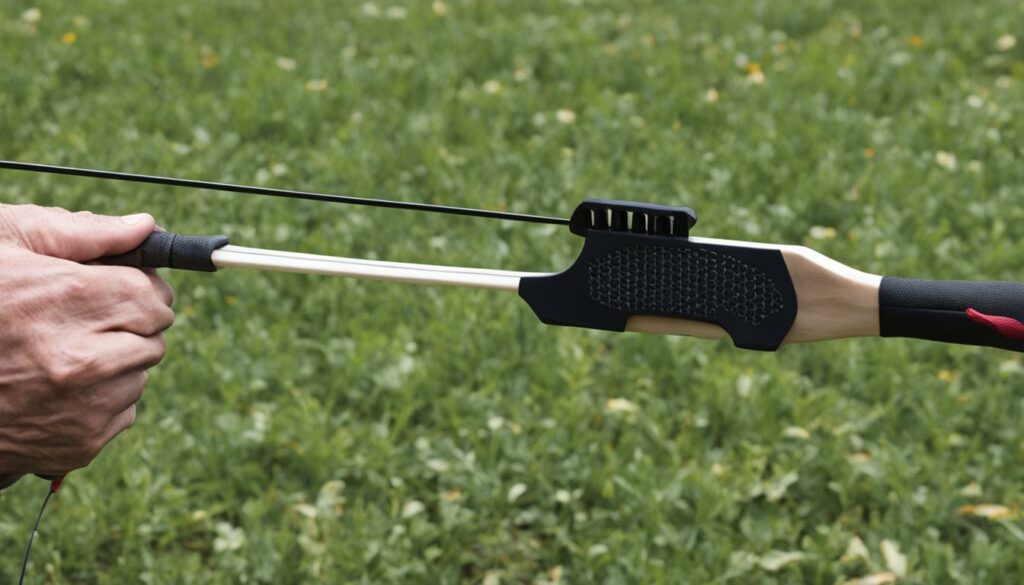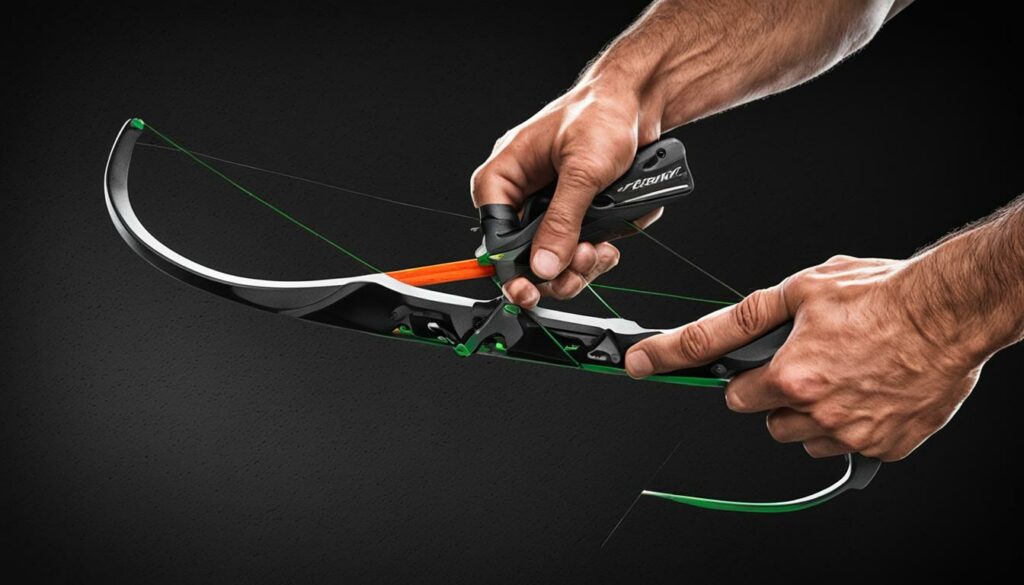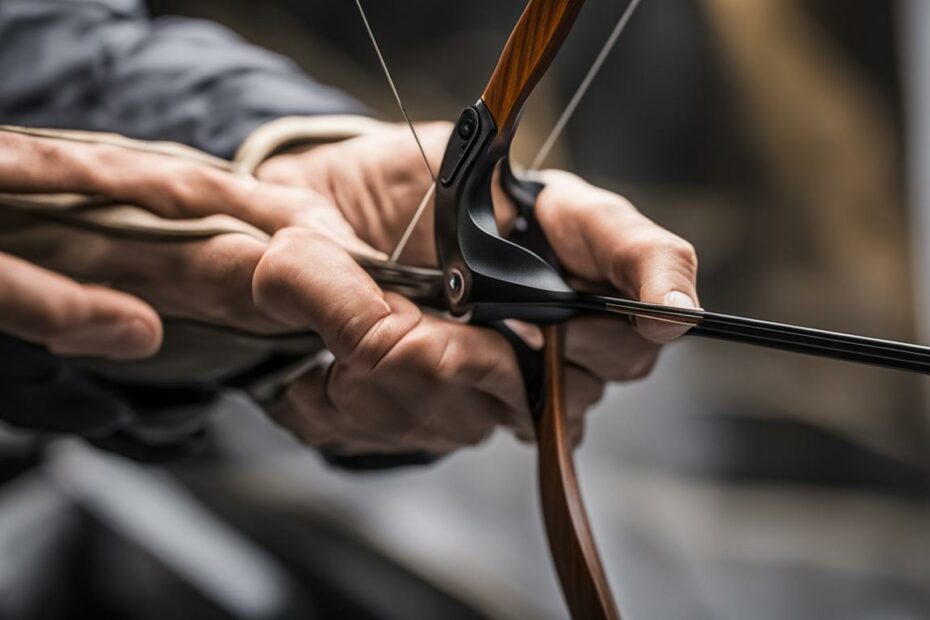Choosing the right recurve bow grip is essential for archers looking to enhance their performance and comfort. A well-optimized grip can significantly impact an archer’s accuracy and shooting experience.
The position of the grip and shelf on the bow is crucial, as it determines the bow’s balance and the archer’s shooting style. Placing the grip in the center of the bow creates a well-balanced bow that is easy to carry and raises smoothly for the shot.
Archers can adjust the tiller and grip location to achieve optimal dynamic balance, which affects the draw stroke and power stroke. Experimenting with grip placement and using tools like the tillering tree can help achieve the perfect balance in the bow.
Investing time in finding the proper grip technique is crucial. Holding the bow with a relaxed hand can significantly improve shooting performance and comfort. Positioning the palm at the base of the thumb, near the lifeline, creates a torque-free shooting position and allows for a consistent grip.
The proper technique for a bow grip involves forming a “V” shape between the thumb and index finger and aligning the center of the bow grip with the line from the deepest part of the “V” to the palm. This ensures a solid hold and maintains the linear alignment of the bow arm and elbow.
Avoiding standard incorrect grips, such as the “death grip” and the “open hand” grip, is essential. The death grip, where the fingers are wrapped tightly around the grip, can lead to inconsistencies in shot alignment. With extended and rigid fingers, the open-hand grip can create pressure points on the riser, resulting in torque and instability.
Consistency in grip technique is key to developing muscle memory and improving shooting accuracy. Practicing correctly griping helps build the foundation for good form and precision. With the proper technique and grip, archers can enjoy a more prosperous and enjoyable archery experience.
Benefits of a Relaxed Bow Hand
Holding the bow with a relaxed hand is essential for improving shooting performance and comfort. By positioning the palm at the base of the thumb near the lifeline, archers can achieve a torque-free shooting position that allows for a smooth and controlled release.
A relaxed bow hand offers several benefits, including:
- Consistent Grip: A relaxed hand promotes a consistent grip on the bow, improving accuracy. When the hand is relaxed, the archer can maintain a consistent hold throughout the shooting, from drawing to releasing the arrow.
- Steadiness: A relaxed hand helps maintain steadiness during the shot. When the hand is tensed or tightly gripping the bow, it can introduce unwanted movement and instability, affecting the aim and overall shooting performance.
- Reduced Bow-Hand Torque: Bow-hand torque occurs when the hand exerts pressure or twists the bow during the shot. This torque can cause left and right misses. Archers can minimize bow-hand torque by relaxing the bow hand and achieving more accurate shots.
Proper Technique for Bow Grip
The proper technique for bow grip is essential for archers to achieve consistency and accuracy in their shots. By mastering the correct grip, archers can ensure a solid hold on the bow and maintain proper alignment of the bow arm and elbow. This section will outline the step-by-step process of achieving the appropriate bow grip technique.
- Forming the “V” Shape: To begin, archers should position their hands to form a “V” shape between the thumb and index finger. This creates a stable foundation for holding the bow.
- Placing the Center of the Bow Grip: Archers should position the center of the bow grip on the line from the deepest part of the “V” to the palm. This ensures a consistent and secure hold on the bow.
- Adjusting Pressure Points: Finding the right pressure point on the hand is crucial for proper grip technique. The ideal pressure point may vary based on the bow’s grip angle. A low wrist grip style is famous for compound bows, while traditional or recurve shooters may prefer a high or medium grip.
- Relaxing Fingers: At full draw, it is essential to relax the fingers and avoid a tight grip or keeping the fingers extended. This contributes to a consistent and torque-free grip, leading to improved accuracy.

Common Incorrect Grips to Avoid
These grips can negatively impact your shooting performance and introduce errors in your aim. Let’s look at each grip and why they should be avoided.
“Death Grip”
The death grip involves tightly wrapping your fingers around the bow grip. This excessive force and tension can lead to issues with elbow alignment and inconsistent left and right shooting.
Holding the bow with a death grip restricts your hand movement and flexibility and hinders your overall control of the bow.
“Open Hand” Grip
The open-hand grip refers to holding the bow with extended and rigid fingers. While it may seem like a relaxed grip, this positioning creates pressure points on the riser, resulting in torque on the bow.
This torque prevents the bow from settling and can throw off your aim. Additionally, an open-hand grip lacks stability and can lead to inconsistent shots.
The death and open-hand grip should be avoided to ensure proper alignment and prevent shooting inconsistencies.
Instead, focus on relaxing your hand and allowing your fingers to rest naturally on the grip. This will provide a stable and accurate hold, enhancing your overall shooting experience.

| Grip | Issues |
|---|---|
| Death Grip | Elbow misalignment Inconsistent left and proper shooting |
| Open Hand Grip | Bow hand torque Lack of stability Inconsistent shots |
Consistency and the Importance of Grip Technique
The amount of practice required may vary depending on individual goals, with hunters typically needing fewer shots per week than competitive target shooters. However, regardless of specific goals, one thing remains constant – the grip technique.
Although there might be slight variations in technique among professionals, the grip remains consistent for accurate results. Modern bow designs with neutral grip geometry are engineered to facilitate better accuracy.
However, the proper grip technique genuinely contributes to a more enjoyable and successful archery experience.
When an archer practices shooting with a consistent grip technique, it helps reinforce muscle memory. As archers repeatedly execute the exact grip, their muscles become accustomed to the specific movements and positions required for a precise shot.
This muscle memory enhances shooting performance by enabling archers to execute the correct grip instinctively without overthinking or introducing unnecessary variables. With muscle memory and a consistent grip technique, archers can shoot more confidently and consistently.
Regular shooting is imperative to reinforce consistent grip technique and develop muscle memory. Repetition is critical to ingraining the correct grip into muscle memory.
Through consistent practice, archers can enhance their shooting accuracy and overall performance while enjoying the satisfaction of hitting the bullseye repeatedly.
FAQ
Why is choosing the right recurve bow grip important?
Choosing the right recurve bow grip is essential to enhance archers’ performance and comfort.
How does grip placement affect bow balance?
Placing the grip in the center of the bow creates a balanced bow that is easy to carry and raises smoothly for the shot.
How can grip location affect dynamic balance?
Adjusting the tiller and grip location can achieve dynamic balance, affecting the draw and power strokes.
What is the proper technique for bow grip?
The proper technique involves forming a “V” shape between the thumb and index finger and placing the center of the bow grip on the line from the deepest part of the “V” to the palm.
What is the benefit of holding the bow with a relaxed hand?
Holding the bow with a relaxed hand allows for a consistent grip, which improves accuracy and reduces bow-hand torque.
What are common incorrect grips to avoid?
The “death grip” and the “open hand” grip should be avoided as they can lead to issues with elbow alignment, torque, and inconsistencies.
How does consistent grip technique contribute to shooting accuracy?
Consistency in grip technique helps develop muscle memory and improve shooting accuracy, building a foundation for good form.
